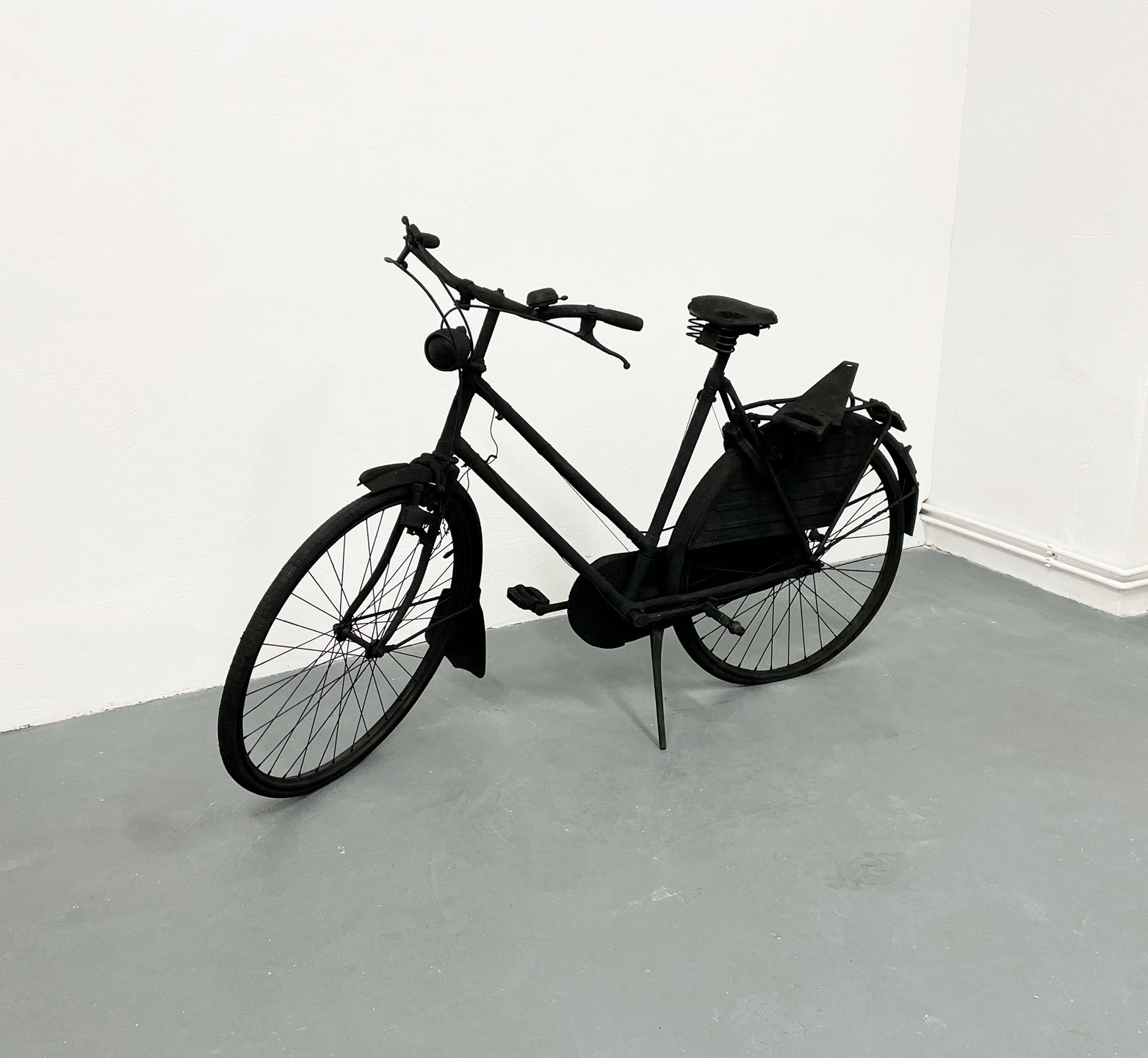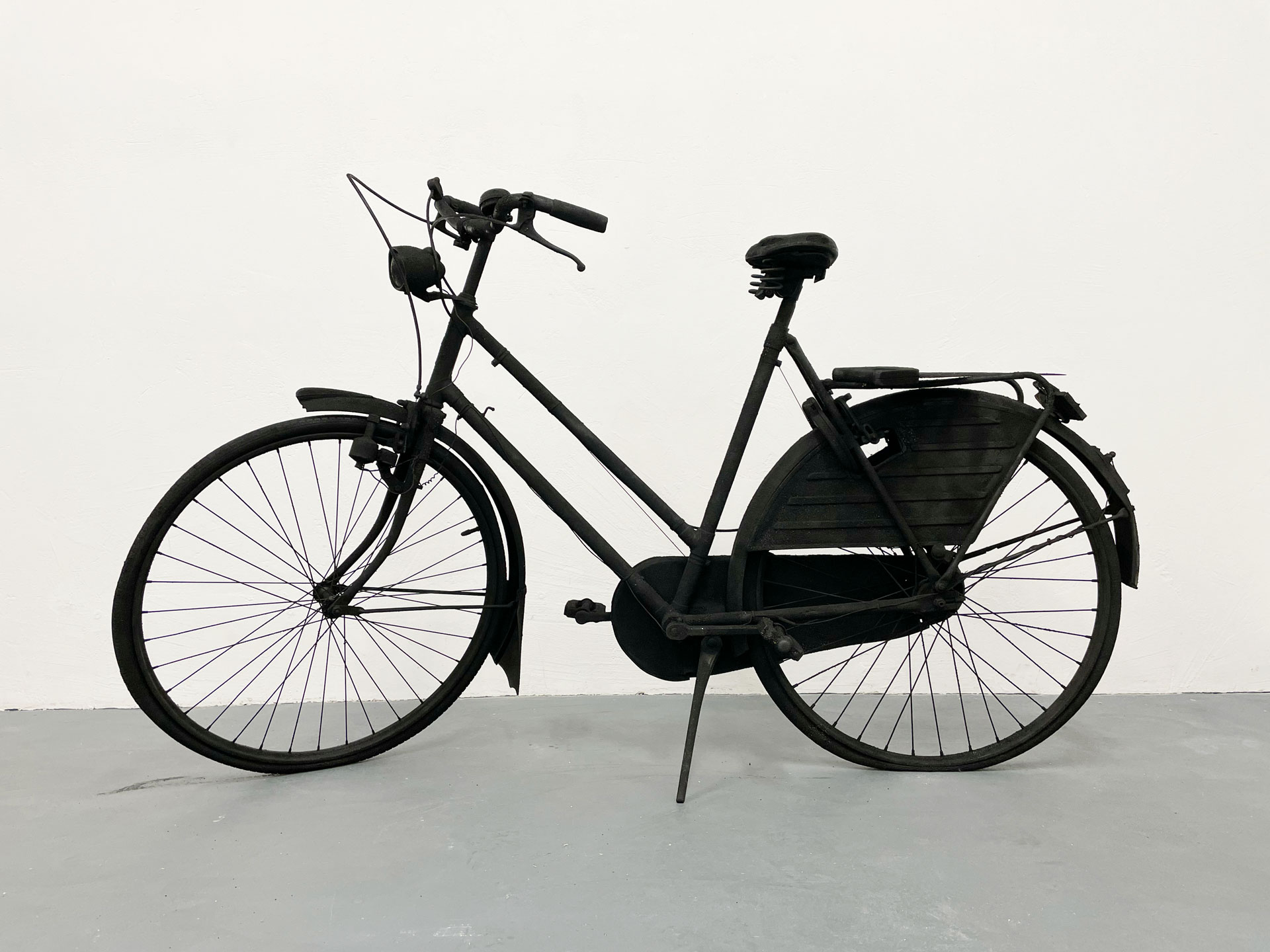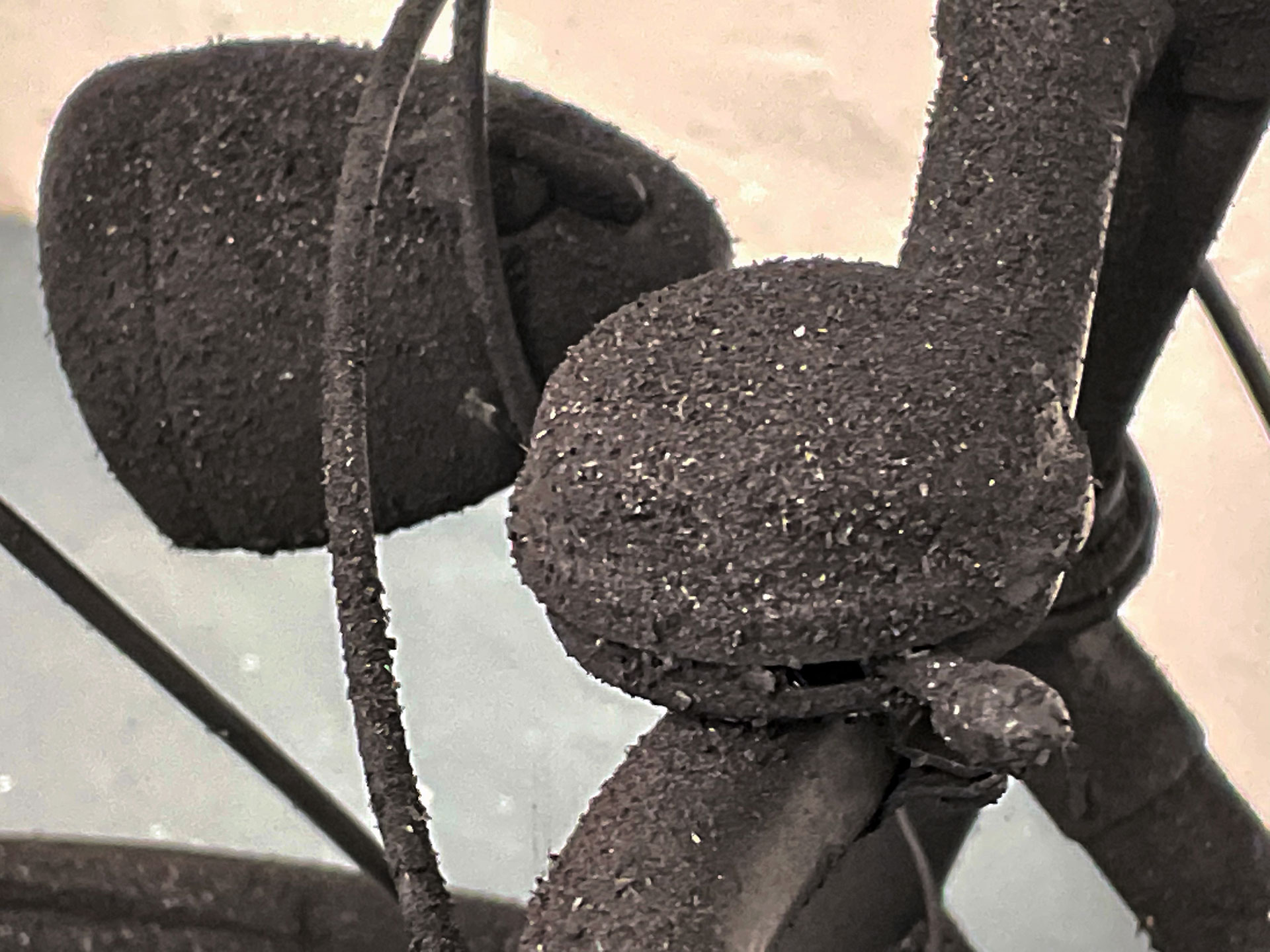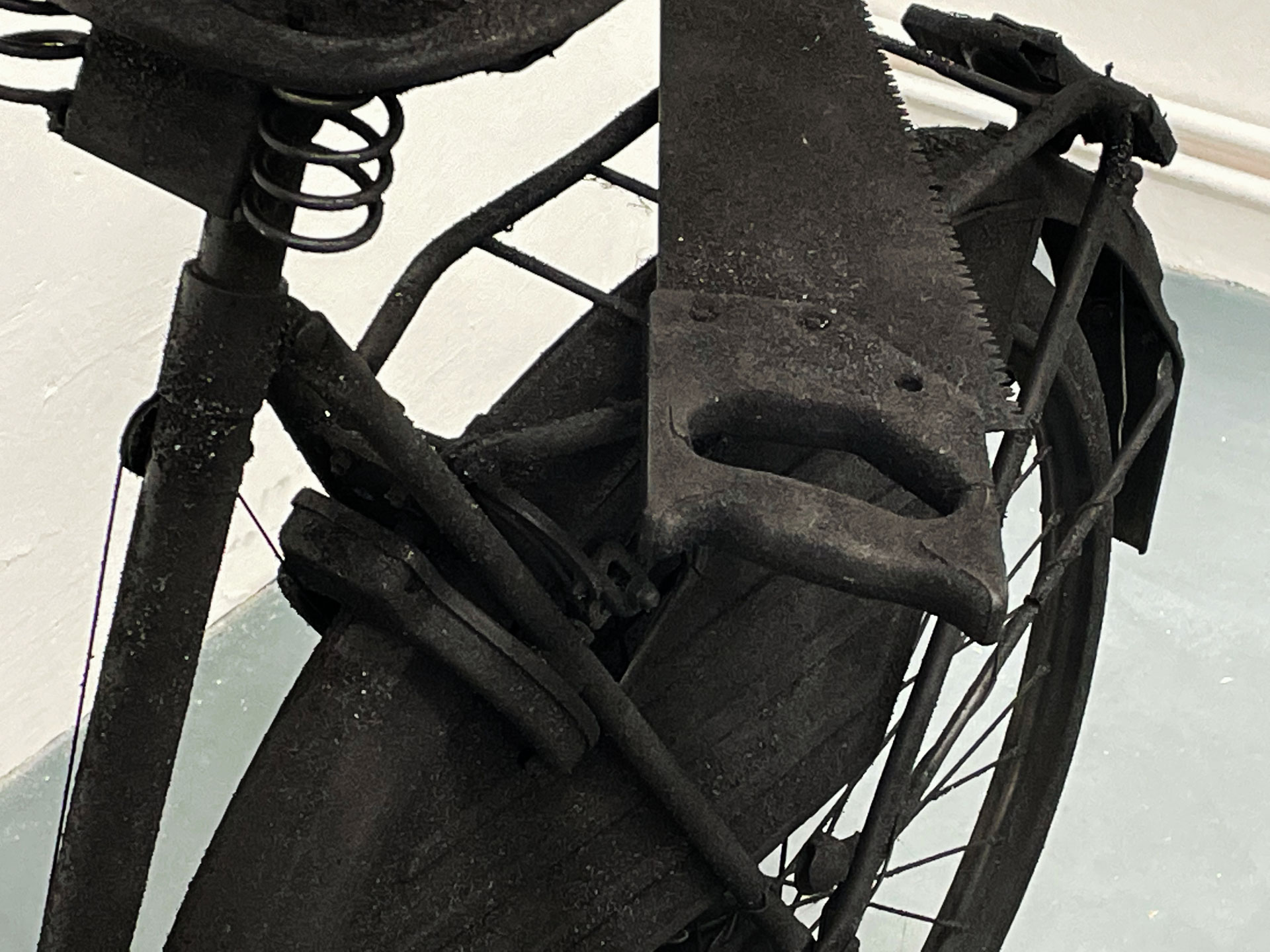In dust things meet (bicycle with handsaw) is part of a bigger series of works (In dust things meet) in which two or three objects that have no connection at all, are forced together in sculpture. The works provoke new stories; a different story for every viewer based on individual interpretations.
This work was specially made for and first hown at In The Rackroom, ran by Lage Egal, Berlin.
year: 2022
material: bicycle, handsaw, charcoal powder.
A TEXT ABOUT IN DUST THINGS MEET BY TIES TEN BOSCH WRITTEN BY SARIE NIJBOER
WAYS OF SEEING
A TEXT ABOUT IN DUST THINGS MEET BY TIES TEN BOSCH WRITTEN BY SARIE NIJBOER
At the core of Ties Ten Bosch’s work lies an observation and understanding of the world around us, a process of constant exploration of what we see and foremost how we see. With each series of work, the artist experiments with the possibilities of seeing. The installation In Dust Things Meet is a continuation of his approach to this experimentation. The work emerged from his residency and artistic project If paradise is half as nice #11, which took place in 2021 in an abandoned GDR department store in Meuselwitz, Germany.
The installation shows everyday objects brought together in a coherent yet surprising composition of different elements, from a fire extinguisher with a condom, a bicycle with a handsaw, and a bottle with a mop and a light bulb, each stacked with numerous layers of charcoal dust. The artist takes the objects out of their context and brings them together in a sculptural manner, forcing a connection among them.
Ties Ten Bosch plays here with what is familiar and unfamiliar in order to create an associative process with the viewer. Playing with perception is used here as a tool for the imagination, allowing new ways of seeing to unfold. Hidden meanings and accidental connections to the staged objects encourage the viewer to create his or her own narrative. The works are brought together as an assemblage with the aim of activating our methods of perception and consequently challenging our perceptual language. Within the philosophy of phenomenology, the experience of seeing is greater than objective research of what we see. The philosopher Merleau-Ponty emphasized this by saying that the body – through which we touch, feel and move – is the primary site of knowledge to the world. He did not believe that there are definitive answers in the world as we experience it; rather, he argued that ambiguity is characteristic of existence. To describe and interpret the meaning of an experience, our consciousness, our language, our cognitive and non-cognitive senses, and our personal, social and cultural assumptions come into play.
Similarly, in the installation In Dust Things Meet, the body plays an important role. As I walk around the objects – searching for new meanings and associations – I am shaped by my consciousness, my sensations, as well as my personal, social and cultural ways of seeing.
Within the installation, each object becomes a fragment in relation to the whole; the fire extinguisher stands next to a condom, a handsaw lies on top of a bicycle, a mop combined with a bottle and lightbulb, forming a surrealistic landscape. Once brought together, the polymorphous narrative of the installation emerges. As with the eyes of a child, I am challenged to search for the questions that arise; why is this placed here, what does it mean, and what do I see here? It turns into a playful encounter with the unknown, which I again might perceive differently from others. This multiple way of seeing is common in the work of Ties Ten Bosch. His installations contain unexpected associations between objects, images, material and meaning that are not given by the artists but are rather to be found by its viewer. By doing so, each work creates unique stories, combining genres and influences, with a sense of humour and imagination.
As much as the work is about perception, it is also a reflection on art. The open interpretations that emerge from Ties ten Bosch his work are reminiscent of the work of Joseph Kosuth. By bringing together alternative interpretations, Kosuth was able to make even a simple wooden chair an object of debate. As with In Dust Things Meet, it is not about finding solutions, but about raising questions. To challenge the viewer, the composition, form and material are carefully chosen for In Dust Things Meet. Sprayed with charcoal dust, the works depict a poetic symbolism. They appear as ready-mades that are seeking an alternative and aesthetic representation of a mass product, in order to reinvent their own language. The simplicity of the works, unified in black dust, reveals a silhouette that brings out the essence of the form. The term silhouette has its origins in its original graphical meaning, the drawing of lines around the human shadow. In the installation, too, the objects are almost like shadows, which, depending on the light, have different ways of being perceived.
While seeing the work, I am reminded of the poem The Waste Land written by T. S. ELIOT in 1922. The poem was written in the aftermath of World War I, and can be seen as a story of brokenness and loss. In the work, too, I cannot help but think of the relationship with decay to something lost, destroyed and burned, in which all that remains is a handful of dust. Dust here, includes everything, it is not merely what has passed but also the space in between, traces of the past, the memory of what once was. Like a silhouette, we are able to recognise it by seeing the empty space around it.
What are the roots that clutch, what branches grow
Out of this stony rubbish? Son of man,
You cannot say, or guess, for you know only
A heap of broken images, where the sun beats,
And the dead tree gives no shelter, the cricket no relief,
And the dry stone no sound of water. Only
There is shadow under this red rock,
(Come in under the shadow of this red rock),
And I will show you something different from either
Your shadow at morning striding behind you
Or your shadow at evening rising to meet you;
I will show you fear in a handful of dust.
Excerpt from T. S. ELIOT, The Waste Land, Section I: “The Burial of the Dead”, Poetry Foundation.



